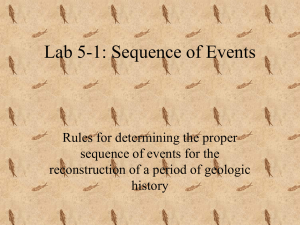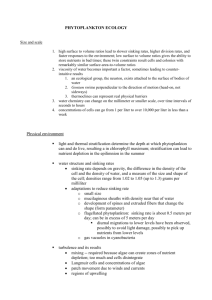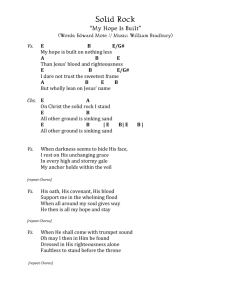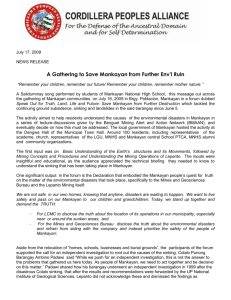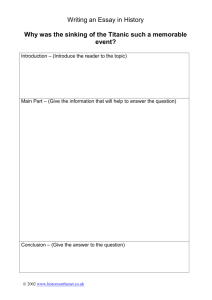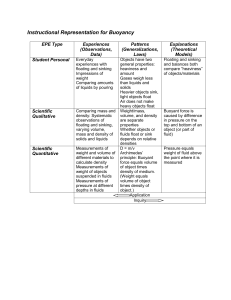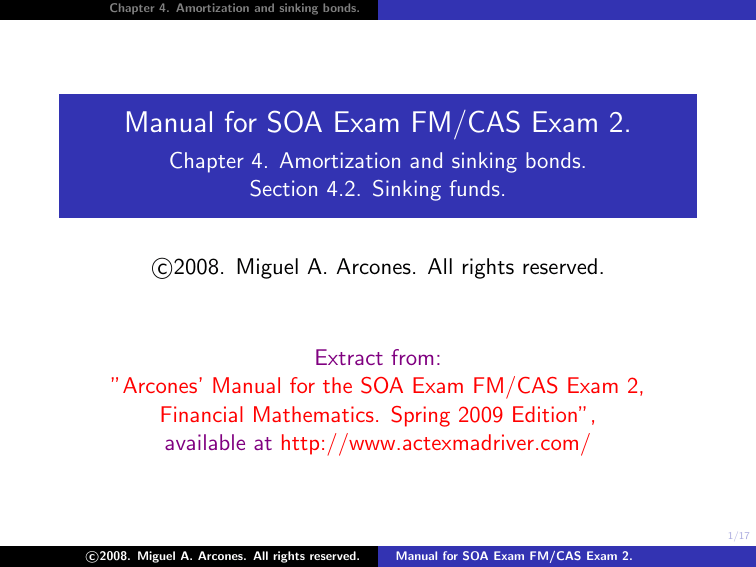
Chapter 4. Amortization and sinking bonds.
Manual for SOA Exam FM/CAS Exam 2.
Chapter 4. Amortization and sinking bonds.
Section 4.2. Sinking funds.
c
2008.
Miguel A. Arcones. All rights reserved.
Extract from:
”Arcones’ Manual for the SOA Exam FM/CAS Exam 2,
Financial Mathematics. Spring 2009 Edition”,
available at http://www.actexmadriver.com/
1/17
c
2008.
Miguel A. Arcones. All rights reserved.
Manual for SOA Exam FM/CAS Exam 2.
Chapter 4. Amortization and sinking bonds.
Section 4.2. Sinking funds.
An alternate way to repay a loan is to make two payments, one
directly to the lender and another to an auxiliary fund. The
auxiliary fund is called a sinking fund. The payments made
directly to the lender apply to the principal. The deposits made
into the sinking fund do not. Usually, the sinking fund accumulates
with a different interest rate than the rate charged by the lender.
At the end of the duration of the loan, the borrower withdraws the
total accumulated in the sinking fund and uses this money to pay
the loan to the lender.
2/17
c
2008.
Miguel A. Arcones. All rights reserved.
Manual for SOA Exam FM/CAS Exam 2.
Chapter 4. Amortization and sinking bonds.
Section 4.2. Sinking funds.
Usually, we consider the case of payments made at the end of each
of n periods. The simplest case is the one when all the payments
are equal. Let i be the periodic effective rate charged by the lender
on the loan. At the end of each period, the borrower pays P
directly to lender. The borrower deposits Q into a sinking fund
earning a rate of interest j. Usually, j < i. The cashflow of
payments to the principal is
Contributions
Time
0
0
P
1
P
2
···
···
P
n−1
P +R
n
where R is the lump–sum payment obtained by withdrawing the
total accumulated in the sinking fund at the end of n periods. The
cashflow of deposits in the sinking fund is
Contributions
Time
0
0
Q
1
Q
2
Q
3
···
···
Q
n
Hence, the accumulated value in the sinking fund at time n is
R = Qs−n−|j .
c
2008.
Miguel A. Arcones. All rights reserved.
Manual for SOA Exam FM/CAS Exam 2.
3/17
Chapter 4. Amortization and sinking bonds.
Section 4.2. Sinking funds.
The borrower’s total cashflow is
Contributions
Time
L
0
−P − Q
1
−P − Q
2
−P − Q
3
···
···
−P − Q
n
The lender cashflow is
Contributions
Time
−L
0
P
1
P
2
P
3
···
···
P +R
n
In order to the loan to be repaid:
L = Pa−n−|i + R(1 + i)−n = Pa−n−|i + Qs−n−|j (1 + i)−n .
4/17
c
2008.
Miguel A. Arcones. All rights reserved.
Manual for SOA Exam FM/CAS Exam 2.
Chapter 4. Amortization and sinking bonds.
Section 4.2. Sinking funds.
Example 1
Dave borrows 150,000 from a trust company at an annual effective
rate of interest of 9.5%. He agrees to pay the interest annually at
the end of the each year, and build up a sinking fund which will
repay the loan at the end of 15 years. The sinking fund
accumulates at annual effective rate of interest of 4.5%. Calculate:
5/17
c
2008.
Miguel A. Arcones. All rights reserved.
Manual for SOA Exam FM/CAS Exam 2.
Chapter 4. Amortization and sinking bonds.
Section 4.2. Sinking funds.
Example 1
Dave borrows 150,000 from a trust company at an annual effective
rate of interest of 9.5%. He agrees to pay the interest annually at
the end of the each year, and build up a sinking fund which will
repay the loan at the end of 15 years. The sinking fund
accumulates at annual effective rate of interest of 4.5%. Calculate:
(i) The annual interest payments.
6/17
c
2008.
Miguel A. Arcones. All rights reserved.
Manual for SOA Exam FM/CAS Exam 2.
Chapter 4. Amortization and sinking bonds.
Section 4.2. Sinking funds.
Example 1
Dave borrows 150,000 from a trust company at an annual effective
rate of interest of 9.5%. He agrees to pay the interest annually at
the end of the each year, and build up a sinking fund which will
repay the loan at the end of 15 years. The sinking fund
accumulates at annual effective rate of interest of 4.5%. Calculate:
(i) The annual interest payments.
Solution: (i) The annual interest payment is 150000(0.095) =
14250.
7/17
c
2008.
Miguel A. Arcones. All rights reserved.
Manual for SOA Exam FM/CAS Exam 2.
Chapter 4. Amortization and sinking bonds.
Section 4.2. Sinking funds.
Example 1
Dave borrows 150,000 from a trust company at an annual effective
rate of interest of 9.5%. He agrees to pay the interest annually at
the end of the each year, and build up a sinking fund which will
repay the loan at the end of 15 years. The sinking fund
accumulates at annual effective rate of interest of 4.5%. Calculate:
(ii) The annual sinking fund payment.
8/17
c
2008.
Miguel A. Arcones. All rights reserved.
Manual for SOA Exam FM/CAS Exam 2.
Chapter 4. Amortization and sinking bonds.
Section 4.2. Sinking funds.
Example 1
Dave borrows 150,000 from a trust company at an annual effective
rate of interest of 9.5%. He agrees to pay the interest annually at
the end of the each year, and build up a sinking fund which will
repay the loan at the end of 15 years. The sinking fund
accumulates at annual effective rate of interest of 4.5%. Calculate:
(ii) The annual sinking fund payment.
Solution: (ii) 150000 = Qs15
and Q = 7217.071217.
−−
|4.5%
9/17
c
2008.
Miguel A. Arcones. All rights reserved.
Manual for SOA Exam FM/CAS Exam 2.
Chapter 4. Amortization and sinking bonds.
Section 4.2. Sinking funds.
Example 1
Dave borrows 150,000 from a trust company at an annual effective
rate of interest of 9.5%. He agrees to pay the interest annually at
the end of the each year, and build up a sinking fund which will
repay the loan at the end of 15 years. The sinking fund
accumulates at annual effective rate of interest of 4.5%. Calculate:
(iii) Dave’s total annual outlay.
10/17
c
2008.
Miguel A. Arcones. All rights reserved.
Manual for SOA Exam FM/CAS Exam 2.
Chapter 4. Amortization and sinking bonds.
Section 4.2. Sinking funds.
Example 1
Dave borrows 150,000 from a trust company at an annual effective
rate of interest of 9.5%. He agrees to pay the interest annually at
the end of the each year, and build up a sinking fund which will
repay the loan at the end of 15 years. The sinking fund
accumulates at annual effective rate of interest of 4.5%. Calculate:
(iii) Dave’s total annual outlay.
Solution: (iii) Dave’s total annual outlay is 14250 +7217.071217 =
21467.07122.
11/17
c
2008.
Miguel A. Arcones. All rights reserved.
Manual for SOA Exam FM/CAS Exam 2.
Chapter 4. Amortization and sinking bonds.
Section 4.2. Sinking funds.
Example 1
Dave borrows 150,000 from a trust company at an annual effective
rate of interest of 9.5%. He agrees to pay the interest annually at
the end of the each year, and build up a sinking fund which will
repay the loan at the end of 15 years. The sinking fund
accumulates at annual effective rate of interest of 4.5%. Calculate:
(iv) The annual effective rate of interest i 0 for which the payments
made at the end of the year will be equal to Dave’s total annual
outlay.
12/17
c
2008.
Miguel A. Arcones. All rights reserved.
Manual for SOA Exam FM/CAS Exam 2.
Chapter 4. Amortization and sinking bonds.
Section 4.2. Sinking funds.
Example 1
Dave borrows 150,000 from a trust company at an annual effective
rate of interest of 9.5%. He agrees to pay the interest annually at
the end of the each year, and build up a sinking fund which will
repay the loan at the end of 15 years. The sinking fund
accumulates at annual effective rate of interest of 4.5%. Calculate:
(iv) The annual effective rate of interest i 0 for which the payments
made at the end of the year will be equal to Dave’s total annual
outlay.
Solution:
(iv) 150000 = (21467.07122)a15
and i 0 =
−− 0
|i
11.52440895%. Notice that although Dave borrows at a rate 9.5%,
by getting only 4.5% in his sinking fund, the actual rate of interest
Dave which is paying is higher.
13/17
c
2008.
Miguel A. Arcones. All rights reserved.
Manual for SOA Exam FM/CAS Exam 2.
Chapter 4. Amortization and sinking bonds.
Section 4.2. Sinking funds.
Example 1
Dave borrows 150,000 from a trust company at an annual effective
rate of interest of 9.5%. He agrees to pay the interest annually at
the end of the each year, and build up a sinking fund which will
repay the loan at the end of 15 years. The sinking fund
accumulates at annual effective rate of interest of 4.5%. Calculate:
(v) Find i + n−1
n+1 (i − j), where i = 9.5%, j = 4.5% and n = 15, and
compare with i 0 .
14/17
c
2008.
Miguel A. Arcones. All rights reserved.
Manual for SOA Exam FM/CAS Exam 2.
Chapter 4. Amortization and sinking bonds.
Section 4.2. Sinking funds.
Example 1
Dave borrows 150,000 from a trust company at an annual effective
rate of interest of 9.5%. He agrees to pay the interest annually at
the end of the each year, and build up a sinking fund which will
repay the loan at the end of 15 years. The sinking fund
accumulates at annual effective rate of interest of 4.5%. Calculate:
(v) Find i + n−1
n+1 (i − j), where i = 9.5%, j = 4.5% and n = 15, and
compare with i 0 .
(15−1)(0.95−0.045)
Solution: (v) i + n−1
= 0.13875.
n+1 (i − j) = 0.095 +
15+1
which is sort of close to 0.1152440895.
15/17
c
2008.
Miguel A. Arcones. All rights reserved.
Manual for SOA Exam FM/CAS Exam 2.
Chapter 4. Amortization and sinking bonds.
Section 4.2. Sinking funds.
Example 2
Steve repays a loan of $18,000 by making interest payment at the
end of the year for 15 years and equal deposits at the end of each
year into a sinking fund for 15 years. At the end of the 15 years,
Steve withdraws the balance from the sinking fund and pays the
loan. The sinking fund earns 6% effective annually. Immediately
after the fourth payment, the yield on the sinking fund increases to
7% effective annually. At that time, Steve adjusts his sinking fund
payment to x so that the sinking fund will accumulate to $18,000,
15 years after the original loan date. Find x.
16/17
c
2008.
Miguel A. Arcones. All rights reserved.
Manual for SOA Exam FM/CAS Exam 2.
Chapter 4. Amortization and sinking bonds.
Section 4.2. Sinking funds.
Example 2
Steve repays a loan of $18,000 by making interest payment at the
end of the year for 15 years and equal deposits at the end of each
year into a sinking fund for 15 years. At the end of the 15 years,
Steve withdraws the balance from the sinking fund and pays the
loan. The sinking fund earns 6% effective annually. Immediately
after the fourth payment, the yield on the sinking fund increases to
7% effective annually. At that time, Steve adjusts his sinking fund
payment to x so that the sinking fund will accumulate to $18,000,
15 years after the original loan date. Find x.
Solution: Let Q be the initial payment Joe makes to the sinking
fund. Then, 18000 = Qs15
. Hence, Q = 773.3297512. The
−−
|6%
balance in the sinking fund immediately after the fourth payment is
773.3297512s−4−|6% = 3383.020703. The final accumulation in the
sinking fund is 18000. So, 18000 = 3383.020703(1.07)11 + xs11
−−
|7%
and x = 689.2751, which can be found doing:
11 N 7 I/Y 3383.020703 PV −18000 FV CPT PMT
c
2008.
Miguel A. Arcones. All rights reserved.
Manual for SOA Exam FM/CAS Exam 2.
17/17

